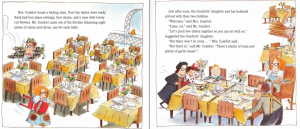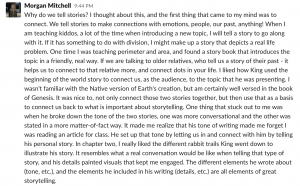
Beyond what a story needs in order to be, what does a story need in order to be good?
Connection is “a relationship in which a person, thing, or idea is linked or associated with something else” (Lexico). A good story will connect a memory, a scent, an emotion, a place with something that the reader is familiar. In the story Entrances & Exits, the author depicts their feelings on certain times and certain places to tell their story. Not only does the author describe what is happening, but they also uses Google Earth to show you were the story took place. I could feel the emotions through their writing, and paired with the street view it awakened new elements to the story. When the reader is going down the street, clicking through the arrows in search for the right one to click on, it can feel like you are lost sometimes, this added an extra layer to me connecting with the narrator.
Putting yourself in the shoes of the reader, can deepen your connectio with the story and the purpose of the story. A good story is something that you leave feeling something, gaining a new point of view, or even learning a new thing! When I was student teaching in a fourth grade classroom, stories were the best way to reach the students. As humans, our line of thought or words may not come across like we want them to on a certain day. I am not particularly stellar at math. Quite frankly, I’m terrible at it; and my highest scoring fourth grader did a better job at explaining than me most days. (Don’t worry – I’m getting better). I was sifting through a pile of books that my host teacher had gifted to me, and found a math book teaching about area and perimeter. I was intrigued as it was our lesson for the day, and thought it would be a good close to the lesson. I put it on my desk to flip through later, and went to work on making some copies. Dragging my feet from the teacher work room to the classroom, questioning if I could actually solve an area and perimeter problem myself, the kids came bounding in from recess. There was giggling, arguing, and one kid jumping over tables as if he was practicing for his Olympic high jump (a compilation if you’d like to visualize even more).

I raced to the front of the room to sit in my chair, a signal to the class that it was time to calm down. Unsure of how to maintain the focus, and switch into math mode. I reached across the desk and quickly grabbed the perimeter and area book. Once I started reading, the student’ ears perked up and were lost in the words.

(Link to the story if you would like to hear in full)
The story talks about how Mr. and Mrs. Comfort use area and perimeter to seat all of their guests in an efficient way. After closing the book, I eyed the manipulatives of cut up straws. I told the students to pair up and gave them each a bag of the straws. I mimicked the story and added and removed guests.
“Jimmy and Sarah are now attending our potluck, but the Hendrix family of seven all got the stomach bug, so they will have to leave.”
Back and forth of guests arriving and guests leaving shaped the straw tables on the floor. Those tiny, straw tables weren’t just showing the accommodations of our fictional guests, but showcased that the students understood the concept. They understood, not because I got in front of a whiteboard and went through a lesson with a few example problems. It wasn’t due to the two workbook pages assigned in the book. It was the unplanned story, and the continuation that we made up along the way, as a class – that helped the students absorbed the information. We did do a few problems on the whiteboard afterwards, but they got it so much faster.
“Hey, Mr. Comfort had a table set up like that problem,” one student cried out.
A student who had trouble with their workbook came up to my desk, showing me the problem. I reworded it for the student.
“If you were throwing a dinner party, and x people showed up and x people showed up, how would you fit them on the table.”
The students connected the story to the equation. They connected the story to their personal experience (the straw tables) and those to the practice problems. The use of stories may be more common in the K-6 classroom setting, but it is certainly not limited to it! Stories can be used as a teaching tool in all settings.
Is there a time that you used storytelling in your practice as an educator? Or even outside your career?
You can use storytelling to understand math equations, culture, history, the list could go on forever. Storytelling and culture go hand in hand, especially in certain cultures. Oral storytelling is the lifeblood of some cultures. This takes me back to chapter two of Thomas King’s “Truth About Stories: A Native Narrative”. In this chapter, King compares the book of Genesis in the Bible and the story of how the Earth floated on the back of a turtle. The works are completely and totally different; yet, trying to convey the same message. It will be like reading through all of the posts that we (students of this class) write. We will be all trying to answer the same question of: what does a story need in order to be good? Though we will all have different answers.
As I mentioned previously, you can learn something from a good story. You can also walk away from a good story feeling emotions, that you wouldn’t have felt if not for that story. I’m not a parent, and I have never been around terminally ill children. Though the author, Paul Zak, of an article entitled, How Stories Change The Brain, sparked emotions within me that help me to connect. I sympathized with the father of Ben, a two and a half year old who has a terminal illness. The article that Zak was writing was not, in itself, a story. Rather, an informational piece to inform how our brain is affected by stories. I connected to the writing, and was interested in the topic because of the stories he told at the beginning of the piece. What made me connect with this story; even though I have no real life experience to relate to Ben’s father?
“Everyone can relate to this story. An innocent treated unfairly, and a protector who seeks to right the wrong–but can only do so by finding the courage to change himself and become a better person” (Zak 2013).
The connection doesn’t have to be blatant, it can be subtle. Zak even connected it to the “hero’s journey’. What is the “hero’s journey”?
“The hero’s journey is a common narrative archetype, or story template, that involves a hero who goes on an adventure, learns a lesson, wins a victory with that newfound knowledge, and then returns home transformed” (MasterClass 2019).
Another author who talked about the “hero’s journey’ was Bryan Alexander in the New Digital Storytelling article.
‘Prob lems can be escalated in scale to a far greater level than the per- sonal, according to the mythic school of story making. This stems from the early 20th century’s anthropological boom, climaxing for storytelling purposes in Joseph Campbell’s The Hero with a Thousand Faces (1949). Campbell claimed to have identified a monomyth of a hero’s journey, an ur- tale or Jungian archetype with deep, regular under pinnings’ The hero is summoned to extraordinary challenge, faces strenuous and even deadly obstacles, overcomes them, and then returns home victoriously. Campbell saw this pattern embodied in myths and ancient stories with local variations, from the lives of Buddha and Christ to Greek epics” (Alexander).
As Alexander said, the monomyth is a common theme in older and even recent stories. If you do a quick google search of Star Wars and the Bible, 51 million results pop of articles trying to compare the two. A recent YouTube video was titled “How Star Wars is a Retelling of The Bible”, articles where they talk about the common themes between the two can all be found in the top ten results. As humans we are programmed to connect. Of course, connect on an emotional level, but also just connect information to prior knowledge, feelings, experiences, or other stories. It is why storytelling is such a powerful tool, it helps us to make more connections to situations we may not come across in our personal life. Stories can help us to absorb information better.
Though it was a lengthier version of my first Slack post (pictured below), I believe connections make a story good .It doesn’t need to be specific connections, but if the reader feels removed from the story then it isn’t worthwhile. The audience needs to feel like they connect with something intellectually, emotionally, and it could go on. With some practice I hope my writing / story telling gets better. I attempted to connect a lot of the works we’ve read and my personal experience to showcase my answer. It may feel like a frog going from lily pad to lily pad with all of these different topics, but that is how my brain processed the information. Once I read something in one article, it reminded me of another article, which reminded me of something I had done before.
What was a connection you made when reading my post?
Slack post:

Morgan, Spaghetti and Meatballs made me laugh! I am so Mrs. Comfort!!!! and fortunately, I am married to Mr. Comfort, who does feed me on a regular basis and helps reduce the stress.
I think parables are a great way to tell a story and make a connection. I think sometimes I feel challenged in finding a way to find a connection for my audience. I’m quite used to feeling like an outlier, or the “odd duck” syndrome that I recently shared with a friend. So my question to you would be how do you build connections within your stories – do you think of your audience first, or do you “begin with the end” in mind?